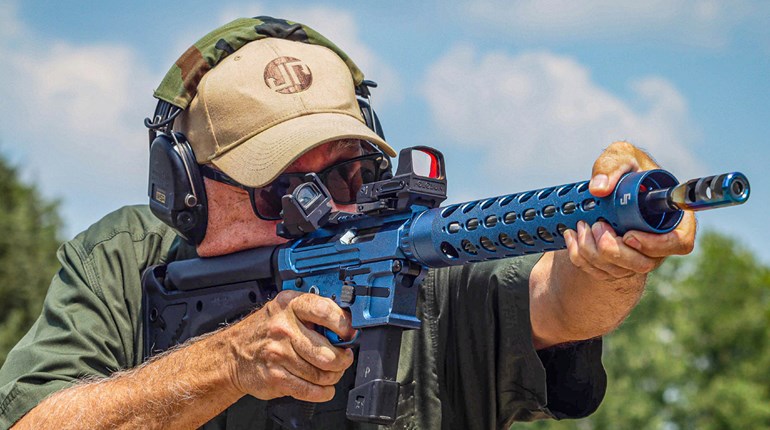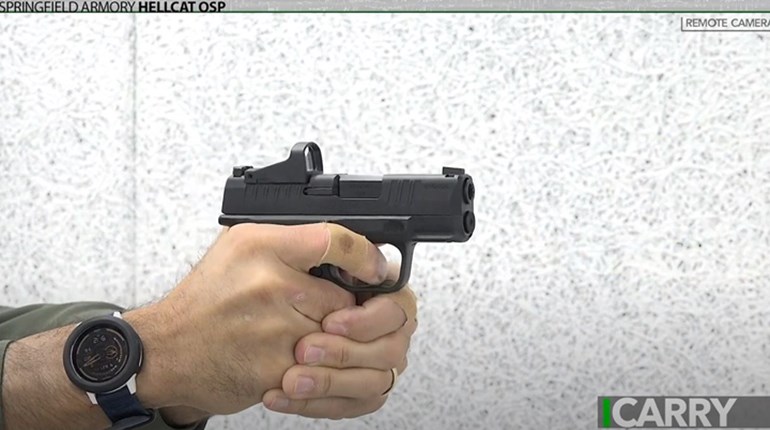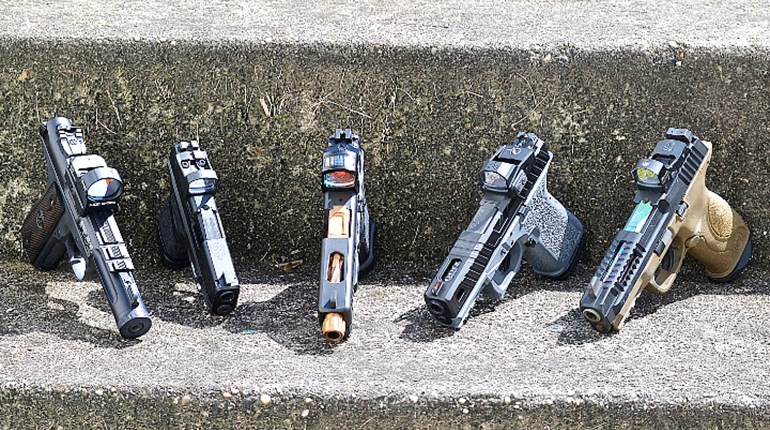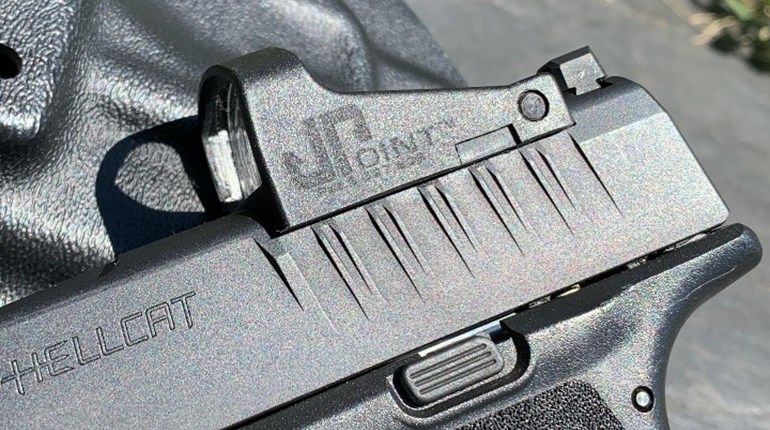
When we bump into enthusiastic shooters who cock an eyebrow and render some version of “huh?” when it comes to pistol caliber carbines, we concede a modest confusion. Granted, expansive diversity is a principal charm of shooting: Within the confines of stuff that goes bang, variety abounds. And mundane or arcane, historical or high-tech, folks are entitled to individual tastes, honorably exercised.
Our perplexity has a different source: We can think of few rivals—ever—to the present white-hot enthusiasm for, and pervasiveness of, pistol caliber carbines (PCCS) in certain circles. Still fewer have deserved such incandescent interest—and if “incandescent” seems overstated, then consider “enduring”: Americans have been ardent fans of the same ammunition in their short and long arms for more than 150 years. We therefore suggest that the application of JP Enterprises’ GMR-15 as a “doubler” for Georg Luger’s 9 mm Parabellum is a profoundly excellent idea. It’s our plan to see that no excuse remains as to how the trend might be missed.
Just as modern analogs do, the mid-19th century rimmed cartridge forebears of present-day PCCS brought desirable energy and accuracy improvements to long arms without imperiling structural integrity and manageability in shorter brethren (energy increases, for instance, can easily be 20 percent when handgun cartridges are fired from a carbine). But when the manually actuated revolver and lever-action platforms of the original heyday gave way to semi-automatic (or even full-automatic in military and law enforcement ranks) applications in the 20th century, reliability problems often dogged the type. Whether jp’s GMR-15 constitutes a 21st-century end to such issues is now glaringly plain: Putting world-class know-how with Stoner/Fremont/Sullivan modern sporting rifles atop the toughest and most reliable pistol cartridge magazine in the world—those of Austria’s vaunted Glock—results in a carbine that strains credulity along many scales.
The heart of the GMR-15 is a blowback action that forsakes the MSR’s standard barrel port gas bleed and locking/rotating bolt. Instead, a heavier bolt carrier, bolt and spring keep the action closed long enough for post-firing chamber pressure to fall to safe levels. When they do, the action opens straight back (no bolt caming), the spent case is extracted and ejected, and a fresh round is fed from any double stack 9 mm Glock magazine.
This takes place courtesy of an extant JP innovation—a tuned “silent capture” spring/buffer design that uses combinations of swappable weights and springs to control cycling. While most users won’t care how it happens—though no one has yet said to us, “Gee, I kind of miss the annoying ka-wang of the spring right under my ear!”—it’s nevertheless a star performer borrowed from their direct impingement rifles. Whether left as it is or tuned to the nth degree to optimize for a special bullet and/or charge weight requirements, smooth recoil is a welcome hallmark, and it’s not common in many other blowback PCCS.
Putting that smoothness to work highlights the next standout GMR-15 attribute—the “roller” version of their well-known JP EZ trigger. Superb triggers have taken on all but commodity status in rifle caliber MSRS, but blowbacks are something of a different animal. At the moment the hammer is supposed to be caught and the trigger reset for a subsequent shot, there’s a tremendous amount of energy bouncing those mechanics around. This can give rise to one, two or all of three issues, none of which are desirable—doubling (two shots when only one was intended), failure to reset (a dead trigger), or very short trigger life (we’ve killed several prestigious triggers in a few thousand rounds in PCCS).
Not so with the EZ. We went to well over 30,000 rounds with one in a predecessor JP GMR-13, and the “roller” configuration brings a substantive geometry benefit to the -15. Here, the traditional curved trigger is replaced by a straight shoe and fitted with an outer sleeve that rotates around the vertical axis. This means that any off-axis pressure of the type that’s inclined to misalign sights and target quite literally rolls to a neutral, re-centered press. Particularly if you’re after the swift trigger manipulations for which the GMR-15 is so well-suited—like the rapidly growing PCC competition venues in USPSA, IDPA and elsewhere—the value of maintaining precise sight alignment needs no explanation. (See “Nuts And Bolts” for a world-class confirmation by pro shooter Todd Jarrett.)
The list goes on. Inside the Mk III handguard system is JP’s Supermatch barrel, complete with red anodized heat sink/diffuser and arguably the envy of the industry. Cryogenically stress relieved, they’re button rifled and air gauged for the best accuracy and can be terminated with either a tactical flash suppressor or competition-oriented compensator (ours). On the test rifle, this was mated with a PSC-17 dual-charging upper that permits either conventional charging at the rear over the buffer tube, or left-side just forward of the chamber. (Fair warning: Once used to side charging, it’s the devil’s own work to go back to conventional!) A variety of stocks and grips are available—Hogue, Mission First Tactical and others—but the installed Magpul needed no improvement and allowed for positive control of the JP during reloads in the beveled magwell.
In the end, we have only one small knock on the GMR-15, and even that is one mostly of perception: weight. When you first latch on to one, a slight “whoa” is hard to suppress, but do. When you shoot the rifle, and especially if you get some skilled instruction, everything but “wow” will fade as if dreamed. Ergo, the JP GMR-15 earns our highest accolade—please, please, please let those smart folks in Hugo, Minn., forget where they sent this one.
Frank Winn has been studying arms and their relationship to tyranny, meaningful liberty and personal security all his adult life. He has been a firearms safety/shooting instructor for more than 20 years, earned state, regional and national titles, and holds Master or Grand Master rank in several competitive disciplines.
Nuts And Bolts
Ammunition – We have long experience with the GMR-15’s predecessor—a GMR-13 with nearly 40,000 rounds through it. There are some ways—no bolt hold-open on an empty magazine, for one—that the -15 trumps it, but one thing that’s happily unaltered is outstanding reliability. Any remotely reputable factory bullet nose shape/weight/power combination functioned 100 percent, as did an astonishing variety of, shall we say, non-standard types. These included projectile weights as low as 90 grains and as high as 165, and overall lengths from .985 to 1.160. The -15 shot them all as unflappably as our -13 does. We know of no other PCCs that are likely to make a challenging claim.
In terms of accuracy, a caution is warranted for PCCs as a type. It may be disappointing not to produce MOA groups with a carbine of the quality of a GMR-15, but it also has little to do with the bore, action, trigger, sight technology, etc. A quick comparison of the ballistic coefficients (BC) may be the easiest way to comprehend the issues. We could only find a single .355 bullet with a BC above .180, and compared to rifle projectiles, this is laughable: Mid .4XXs to low .5XXs are common in calibers famous for their accuracy, and some from our friends at Sierra boast BCs in the high .7XXs and even low .8XXs. If that weren’t enough, pistol bullet BCs generally fall as velocities increase—the opposite of rifle bullets.

Just the same, multiple national and world title winner and Vista Outdoors shooter Todd Jarrett supplemented our tests during a class, and dispelled any practical accuracy concerns by hammering a 75-yard, 12-inch steel. Long, rapid strings of hits from the JP (and well faster than we can press the trigger at all) using a Hornady-topped 100-grain load of our confection drew his wry approval. Jarrett’s own PCC ammo—based on a 124-grain projectile—provides useful rifle-caliber training out to 300 yards, he told us. Best of all—and as Todd rightly reminded us—a pistol ammo/carbine-style rifle combination is an economical, worthy substitute for applications where a rifle caliber MSR would be out of the question.
Optics – To hit at longer ranges, you need to be able to see at those ranges. So we made a mid-review departure from PCC mainstay C-More Railway (though it thoroughly impressed aboard the GMR too), opting for an early chance at the Nightforce ATACR 1-8x24 F1 optic. Intended mainly for 3-Gun applications, this lightweight thoroughbred (21 ounces) is a giant killer in many respects, but proved especially lethal to one PCC canard—the idea that only red dots/reflex optics need apply for PCC use.
It is true that more precise head positioning makes tube-type optics slower in the mount of the carbine (about .08-.10 seconds for us, though Jarrett—no surprise—unceremoniously halved this). But the excellent FC-DM illuminated reticle and true 1x makes any disadvantage extremely short lived. We tested this going both eyes open and head-to-head with a red-dot-equipped MSR-pattern rimfire we’ve shot a lot, and lost in a Steel Challenge half match. There’s no way a 9 mm should edge the rimfire given the latter’s recoil advantage, but the Nightforce reticle at 1x takes on all the characteristics of a top-quality, biggish dot (which we prefer). Even in punishing midday light, “dot” visibility and peripheral awareness were grand, with target-to-target transitions proceeding apace.
Once shots moved beyond 75 yards, the trim Nightforce eclipsed all comers with ease. Routine hits at 200 yards depended altogether on the shooter—ammunition, rifle and optic did their work as though born to it. From stem to stern, the Nightforce is everything there is to want: a light weight for power; crystal clear, dot-like, both-eyes-open performance (at 1x, though you can learn to do it at higher powers, too); and possessed of utterly precise controls and repeatable performance to impressive distances.


































